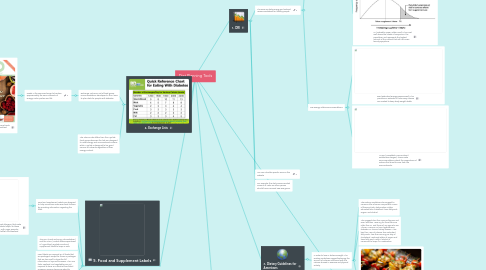
1. 4. Exchange Lists
1.1. Exchange Lists are a set of food-group recommendations developed in the 1950s to plan diets for people with diabetes.
1.1.1. Foods in the same exchange list contain approximately the same amounts of energy, carbs, protein and fat.
1.1.1.1. Now called "Choice Lists," they group foods based on their calorie and macro-nutrient composition.
1.2. The Choice Lists differs from the MyPlate food groups because the lists are designed to meet energy and macronutrients criteria, while, MyPlate is designed to be good sources of nutrients regardless of their energy content.
2. 5. Food and Supplement Labels
2.1. Food and Supplement Labels are designed to help consumers make wise food choices, by providing information regarding the food.
2.1.1. There are 8 major food allergens, that make food and supplement labels helpful to those allergic. These include: milk, eggs, peanuts, tree nuts, soy, wheat, shellfish, and seafood
2.2. The FDA (Food and Drug Administration) and the USDA (United States Department of Agriculture) regulate Food and Supplement labels to keep us safe.
2.3. Food labels are required on all foods that are packaged, except for those in packages that are too small to show the full information or by small business. Also, raw fruits, seafood, and vegetables are not required to have an individual food label. However, grocery stores are asked to provide nutrition information for these products. Some of the other places not required to carry food labels is from an establishment like a restaurant, bakery, and delicatessen. Although, food chains that have 20 or more locations must list calorie content information for standard menu items.
3. Vegetables (2 1/2 cups): Consume various vegetables instead of eating the same one all of the time. (Aim for about 1 1/4 cups dark green, 5 1/2 cups red and orange, 1 1/2 cups beans and peas, 5 cups starchy,and 4 cups other veggies per week.
4. 1. DRI
4.1. The DRIs are daily Energy and nutrient recommendations for healthy people
4.1.1. DRI Nutrient Intake Recommendations
4.1.1.1. EAR (Estimated Average Requirement): Average amount of a nutrient for good health.
4.1.1.2. RDA (Recommended Dietary Allowance): This is set by adding a safety factor to the EAR.
4.1.1.2.1. AI (Adequate Intake) - is the recommended average daily intake level based on observed or experimentally determined approximations or estimates of nutrient intake by a group (or groups) of apparently healthy people that are assumed to be adequate – used when an RDA cannot be determined.
4.1.1.3. UL (Tolerable Upper Intake Level): This is set well above the needs of everyone in the population and represents the highest amount of the nutrient that will not cause toxicity symptoms.
4.1.2. DRI Energy Intake Recommendations
4.1.2.1. EER (Estimated Energy Requirement): This provides an estimate of how many calories are needed to keep body weight stable.
4.1.2.2. AMDR (Acceptable Macronutrient Distribution Ranges): These make recommendations about the proportions of calories that should come from the macronutrients.
4.2. You can calculate specific DRIs on this website
4.3. For example, the daily recommended amount of carbs an active person should have is around 300-500 grams.
5. 3. MyPlate
5.1. Provides healthy recommended portions. MyPlate can be used to plan a diet to lose or balance weight. MyPlate helps balance calories, and to see which foods to increase or decrease.
5.1.1. Grains (6 ounces): Make half of the grains consumed be whole. (aim for 3oz of whole grain per day)
5.1.2. Fruits (2 cups): Focus mostly on fruits, make your choice of fruit vary, and eat the fruit whole or cut up instead of the juice.
5.1.3. Dairy (3 cups): Do not forget about your calcium rich foods. When consuming dairy (such as milk, yogurt, cheese etc.) choose the fat-free or low-fat option for less calories and the same amount of nutrients.
5.1.4. Protein/Meat (5 1/2 oz): Twice a week, make seafood your source of protein. Make sure to vary your protein routine, and keep meat and poultry portions small and lean.
6. 2. Dietary Guidelines for Americans
6.1. In order to lose or balance weight, The Dietary Guidelines suggest balancing the amount of calories consumed with the calories burned in exercise and physical activity.
6.1.1. The Dietary Guidelines also suggest to consume less of some components. Some of these include; daily sodium intake, saturated fats, cholesterol, trans fatty acid, sugars, and alcohol.
6.1.2. This suggests less than 2300 milligrams and even less than 1500 mg for those who are older than 51 and those of any age who are African American or have hypertension, diabetes, or chronic kidney disease. Also, less than 10% of calories from saturated fatty acids. Less than 300 mg per day of cholesterol. Reduced intake of sugars and trans fatty acid. Lastly, if alcohol is consumed to keep it in moderation.
6.1.3. However, the Dietary Guidelines suggest to add some foods and nutrients to ones diet. It recommends adding fruits and vegetables as a part of eating healthy while staying inside the needed calories. Dark green, red, and orange vegetables, beans and peas are very healthy. It says to choose a variety of protein foods such as seafood, lean meat and poultry, eggs, soy products, and unsalted nuts and seeds.
